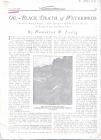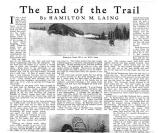1
A diploma for a commercial storywriting course completed by Laing.19 January 1905
Indianapolis, Indiana, U.S.A
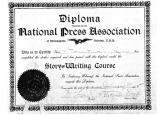
2
Certainly one of the more notable aspects of Laing's work and character was his prolific writing career. Not only was Laing scrupulously faithful in writing his diary and in his mail correspondence, he also wrote some 24 scientific articles for major ornithological periodicals, and nearly 700 articles on various aspects of natural history for popular magazines and newspapers. He also produced ten books over the course of his life, three of which were published in full, and one of which was largely serialized by the Toronto Globe.4
A notable exception in Laing's writing is his first piece of fiction, "End of the Trail," published in 1907. This reflects the early influence of Ernest Thompson Seton on Laing's thoughts – "End of the Trail", while subtly displaying Laing's intricate knowledge of hunting and the wilderness, is still very much a Setonesque, quasi-Romanticized epic featuring anthropomorphized animals and Noble Savages.5
One of Laing's earliest literary influences was Ernest Thompson Seton, who wrote animal adventure stories based on his own experiences as a naturalist in the late nineteenth century. These stories were quasi-Romantic pieces of fiction, in which animals were largely anthropomorphized.6
Other naturalist writers of the time, who would also become tremendous influences on Laing, criticized Seton for his artistic license. Writers and naturalists such as John Burroughs and U.S. President Theodore Roosevelt opposed Seton with a philosophy of realism. They believed that the situations and actors found in nature ought to be represented as faithfully as possible; serious naturalists should not project human traits and values onto nature, which is what Seton did. While Laing's "End of the Trail" piece is very much a Romanticized, Setonesque piece of fiction, depicting a deadly and cathartic duel between a "Noble Savage" First Nations hunter and his arch-enemy the wolf, this seems to have been his only published piece written in this style.7
An article by Laing, which appeared in the ''Canadian Geographic Journal'' in April 1937.April, 1937
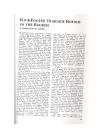
8
In Laing's later writing, however, his realism became more pronounced. This may well be due to the influence of naturalists such as John Burroughs and Theodore Roosevelt, who denounced "nature fakers" who were unfaithful to the truths of natural history.9
The cover of Laing's biography of his friend and colleague, Allan Brooks, published in 1979.1979
Comox, British Columbia, Canada
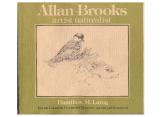
10
Laing's first book, published in 1913, is called "Out With the Birds". He also published a book with P.A. Taverner and R.M.. Anderson titled, "Birds and Mammals of the Mt. Logan Expedition, 1925." Laing's third book, "Allan Brooks: Artist-Naturalist", a biography of his friend and fellow ornithologist, was published in 1979. "Bird Rambles in British Columbia", another piece of Laing's, was serialized by the NY Tribune. Other books written by Laing, but never published, include: "Three Moniases Down North", "Rural Felicity", "Canadian Nature Studies", "Romance of a Stump-Ranch", "My Neighbours of the Western Shore", and "Birds of Lake Athabasca".11
An article of Laing's which appeared in 'Forest and Outdoor' magazine.February, 1929
Comox, British Columbia, Canada
